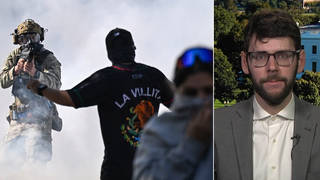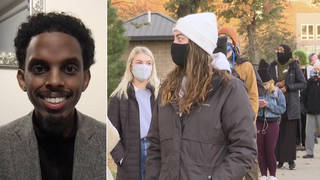
Guests
- Ibram Kendifounding director of the Antiracist Research and Policy Center at American University.
This week marks two years since white supremacists descended on Charlottesville, Virginia, where a neo-Nazi drove his car into a crowd of antiracist protesters, killing 32-year-old activist Heather Heyer. Days later, President Trump claimed there were “very fine people on both sides.” Since Charlottesville, white supremacists have committed at least 73 murders, according to the Anti-Defamation League. Just last week, a white supremacist in El Paso, Texas, opened fire in a crowded Walmart and killed 22 people. It’s been described as the deadliest attack to target Latinos in modern American history. We speak with Dr. Ibram X. Kendi, founding director of the Antiracist Research and Policy Center at American University and author of the new book, “How to Be an Antiracist.”
More from this Interview
- Part 1: “Today the Lynch Mob Only Needs an Assault Rifle”: Ibram X. Kendi on White Supremacist Violence
- Part 2: Ibram X. Kendi: IQ Tests, SAT Scores and Other “Intelligence” Tests Propagate Racism
- Part 3: How to Be an Antiracist: Ibram X. Kendi on Why We Need to Fight Racism the Way We Fight Cancer
- Part 4: Ibram X. Kendi on Trump, Obama & Why “Internalized Racism Is the Real Black-on-Black Crime”
Transcript
JUAN GONZÁLEZ: This week marks two years since white supremacists and neo-Nazis descended on Charlottesville, Virginia. On the night of August 11th, 2017, hundreds of white men bearing torches marched on the University of Virginia campus, chanting “Jews will not replace us” and “white lives matter.” On the following day, a neo-Nazi drove his car into a crowd of antiracist protesters, killing Heather Heyer, a 32-year-old activist. Days later, President Trump claimed there were, quote, “very fine people on both sides.”
Since Charlottesville, white supremacists have committed at least 73 murders, according to the Anti-Defamation League. Just last week, a white supremacist in El Paso, Texas, opened fire in a crowded Walmart, killing 22 people, mostly Latinos. It’s been described as the deadliest attack to target Latinos in modern American history.
AMY GOODMAN: The El Paso gunman wrote a manifesto that contained language similar to the racist rhetoric of President Trump and prominent right-wing figures, including Rush Limbaugh and Tucker Carlson. This comes as Trump is facing increasing criticism for his racist remarks. Last month, the Democratic-controlled House voted to condemn Trump’s racist attack on four freshmen congresswomen of color — Congressmembers Ayanna Pressley, Alexandria Ocasio-Cortez, Rashida Tlaib and Ilhan Omar. Trump had told them to, quote, “go back and help fix the totally broken and crime infested places from which they came.” Three of the four congresswomen were born in the United States. But Trump has dismissed claims he’s stoking racial tension.
PRESIDENT DONALD TRUMP: I am the least racist person there is anywhere in the world. When con men, who I’ve known long — you know, almost all my business life, because I had to deal with him, unfortunately, in New York, but I got along with him — Al Sharpton. Now, he’s a racist.
AMY GOODMAN: Well, we’re joined right now for the hour by Ibram X. Kendi, the founding director of the Antiracist Research and Policy Center at American University in Washington, D.C. His new book is out today, How to Be an Antiracist. It’s his follow-up to Stamped from the Beginning: The Definitive History of Racist Ideas in America, which won the 2016 National Book Award for Nonfiction. Kendi was just 34 years old at the time, the youngest winner of the National Book Award for Nonfiction. His latest piece for The Atlantic is headlined “A Lynch Mob of One: The assault rifle has enabled racists to act alone.”
Ibram X. Kendi, welcome to Democracy Now! Congratulations on the release of your book, and happy birthday.
IBRAM X. KENDI: Thank you.
AMY GOODMAN: Let’s begin on a less happier note, which is what took place in El Paso, what’s considered one of the largest Latino slaughters in this country in its history. You have written this very interesting piece for The Atlantic, “A Lynch Mob of One.” Explain.
IBRAM X. KENDI: Sure. So, one of the worst race riots, as they were called, in 1919, hundred years ago, during what was known as the Red Summer because there was this series of race riots — the worst, potentially, happened in Chicago. And the last day of that race riot in Chicago was August 3rd. Exactly a century later, we had what happened in El Paso. And those lynch mobs a century ago, they needed to have large and coordinated numbers of people in order to essentially slaughter large numbers of people of color. But today the lynch mob only needs an assault rifle. And we saw that in El Paso, Texas.
AMY GOODMAN: So, what needs to be done about it?
IBRAM X. KENDI: It needs to be — I think we need to, first and foremost, recognize how an assault rifle, one gun, one AR-47, one AR-15, could literally lead to many people dying, with this combination of racist ideas. This shooter in El Paso had both. He had this assault rifle and an assault rifle of racist ideas. And we need to figure out a way to control, if not ban, both of them.
JUAN GONZÁLEZ: And, of course, that shooter was — his manifesto had eerie echoes of many of the words of President Trump these days about an “invasion” occurring of the United States. You just heard that clip that we played of President Trump saying he’s the least racist person anywhere in the world. Your reaction when you hear not only that, but the number of people who still support him and his views and perspectives in the country?
IBRAM X. KENDI: Well, I would say he’s probably the least antiracist person anywhere in the world. And his denial of his racism is essential to racism itself. Even the El Paso shooter, at the end of his manifesto, he denied his own racism. I mean, can you imagine that, writing this manifesto, demonizing Latinx people over and over again, telling the nation that you — that they were invading and that you were protecting the nation, and then saying, at the end, “Well, they’re just going to call me a racist, even though I’m really not”? I mean, and that’s why — I mean, denial itself is that heartbeat. And I think, in contrast, an antiracist is seeking to acknowledge and admit, which is certainly something that Trump has never done.
AMY GOODMAN: So, we’re going to break, and then, when we come back, we’re going to talk about the difference between a nonracist and an antiracist, and that’s really fundamental to your new book, again, released today, How to Be an Antiracist, by Ibram X. Kendi, professor of history and international relations, founding director of the Antiracist Research and Policy Center at American University. Stay with us.











Media Options